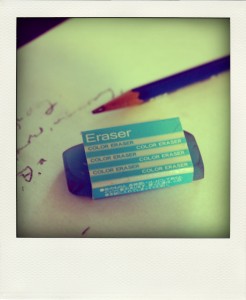
Today’s prompt asks you to write an erasure poem. The exercise itself is straightforward and accessible: take a piece of text (any text), and erase, cut, or obscure words from it in order to excavate new constellations of sound, image, and meaning. But the simplicity of this method belies both the complex political implications of the act of erasure and the aesthetically and critically evocative possibilities of its results.
On the level of craft and aesthetic practice, erasure is an exercise in creative disruption: it approaches a text not as an authoritative tome, but as a playground. It pulls apart syntax and meaning, joyfully discarding the scaffolding of the author’s original intent, in order to generate new and often delightfully spontaneous meanings from the chaos that results. It gets our brains to think outside of existing constructions of language and argument, and playfully diffuses the authority of the published (public) page, instead placing agency and ownership of a text into the hands of the reader / artist who rearranges and re-imagines it.
On another level, though, the practice of erasure is also deeply subversive in a political sense. To author a text, to be among the ranks of those whose voices are heard in the public sphere (through public oratory, through publication), necessarily invests a speaker with a measure of social and cultural power, and so to engage in creating new texts by erasing portions of another one can be to participate in a type of protest against formal systems of language and power. The practice of erasing, or silencing, marginal voices is a tool that has long been wielded by those who seek to propagate and maintain systems of injustice, and so to uproot and disrupt, to excavate and re-write texts that come from unjust powers by erasing and reclaiming them is to turn that tool against itself.
Early this year, I began reading Srikanth Reddy’s Voyager, in which he uses the exercise of erasure to excavate and subvert the memoir of former UN Secretary-General Kurt Waldheim, who in 1985 was revealed to have been a Nazi SS officer. Reddy’s (to quote Marjorie Perloff’s blurb) “using, abusing, recycling, and reformatting [of] Waldheim’s own words” in multiple, complex configurations destabilizes the authority of Waldheim’s text by deftly using the framework of its language to construct transient arrangements that are by turns at odds with, and at times, utterly irrelevant to, the presumed argument of the original memoir. By doing this, Reddy enacts the shifting identities and masks that Waldheim claimed in his lifetime, laying bare the multiplicitous/duplicitous nature of the public persona he constructed for himself. From the remains of Waldheim’s shredded sentences, Reddy carefully excavates and floats before us a man whose seems utterly alienated from—even coolly oblivious to—the import of his ostensible mission. The narrative of peacemaking betrays itself, and, having splintered, the voice Reddy produces hovers in the space of the page, transmuted, antique, foreboding, and at times, almost faceless.
Reddy’s book is not the only erasure project that has caught my attention recently. When I read LR Issue 2 contributor W. Todd Kaneko’s poem “Quarry” a couple of months ago, I was also deeply intrigued by its use of the technique. First published to the blog 99 Poems for the 99 Percent back in January, “Quarry” engages in the unusual act of erasing portions of itself. Kaneko cleverly uses HTML to apply black backgrounds to sections of the text, in order to make them appear to have been “blocked out” or “censored”—that is, until the reader highlights the missing text with his or her mouse, and the missing words are revealed. “Quarry” thus exists as two simultaneous poems—the first, a public poem, notable for what it is missing, and the second, a “hidden” poem, which is accessible to the reader only if he or she possesses the curiosity to engage in some investigative work during the act of reading.
Indeed, asking the reader “dig” appears to have been at the heart of the Kaneko’s intentions for this piece. In the description that follows the poem, he writes:
I was thinking about how a writer often has to dig around in a poem
to figure out what it’s doing and what it wants to do. I was thinking
about how we kinda have to dig around in the OWS movement to figure
out what precisely is happening there. I was thinking about how so
much of this decade’s unemployment rates and economic woes are tied to
decisions and practices that people have been overlooking for decades.
I was thinking about using HTML to make a reader dig around in a
poem—use your mouse to select the text and unearth the rest of the
poem.
“Quarry,” then, in inviting the reader to reverse the poet’s act of self-erasure, brings us closer to the process of excavation inherent in creation and challenges the notion that to read uncritically and without careful investigation is to understand a whole picture (of a poem, of a political movement). To generate meaning, the artist, the politician, the protester, must engage in a process of thoughtful culling and “digging”—but to responsibly interpret that meaning, the reader must also engage in excavation, too. Neither art, nor politics, then, exists exclusively on the surface. It is only by digging through what has been hidden or erased that we can approach a fuller understanding of what we see before us (whether dinosaur, poem, or protest).
Prompt: Create a poem from the words of another text by erasing portions of the source until something new and evocative is generated. OR, create a poem that engages in doubling back on, negating, or even physically erasing, portions of itself.